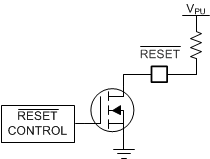SBVS300A November 2016 – September 2021 TPS3851
PRODUCTION DATA
- 1 Features
- 2 Applications
- 3 Description
- 4 Revision History
- 5 Pin Configuration and Functions
- 6 Specifications
- 7 Detailed Description
- 8 Application and Implementation
- 9 Power Supply Recommendations
- 10Layout
- 11Device and Documentation Support
- 12Mechanical, Packaging, and Orderable Information
Package Options
Mechanical Data (Package|Pins)
- DRB|8
Thermal pad, mechanical data (Package|Pins)
- DRB|8
Orderable Information
8.2.2.2 Calculating RESET and WDO Pullup Resistor
The TPS3851 uses an open-drain configuration for
the RESET circuit, as shown in Figure 8-4. When the FET is off, the resistor pulls the drain of the transistor to VDD and
when the FET is turned on, the FET attempts to pull the drain to ground, thus
creating an effective resistor divider. The resistors in this divider must be chosen
to ensure that VOL is below the maximum value. To choose the proper
pullup resistor, there are three key specifications to keep in mind: the pullup
voltage (VPU), the recommended maximum RESET pin
current (IRESET), and VOL. The maximum
VOL is 0.4 V, meaning that the effective resistor divider created
must be able to bring the voltage on the reset pin below 0.4 V with
IRESET kept below 10 mA. For this example,
with a VPU of 1.8 V, a resistor must be chosen to keep
IRESET below 50 μA because this value is the
maximum consumption current allowed. To ensure this specification is met, a pullup
resistor value of 100 kΩ was selected, which sinks a maximum of 18 μA when
RESET or WDO is asserted. As
illustrated in Figure 6-13, the RESET current is at
18 μA
and the low-level output voltage is approximately zero.
 Figure 8-4 RESET Open-Drain Configuration
Figure 8-4 RESET Open-Drain Configuration